
Carol Klein welcomes us to Life in a Cottage Garden at her home Glebe Cottage, Chittlehamholt near Umberleigh Devon 15 miles from the coast.
For over 30 years Carol has looked after the garden which is loved not only by herself but her family too and she knows every part of the soil and the plants.
She loves spending time in the garden and enjoying the peace of the surrounding countryside.
Every season brings delight, challenges and problems 'but that's the thing about gardening, it's ever-changing and its's always exhilarating.
Over the 6 episodes Carol is going to show a whole year in the garden 'how it grows, flourishes, dies and is reborn'.
Over the 30 years there has been lots of continuous changes in the garden some of them quite dramatic from when they first came to the garden when it was full of sheds and old cars.
Carol is in the Brick Garden, so called because of the brick paths and contains loads of grasses so its constantly moving as well as her hot beds that are dormant for the Winter.
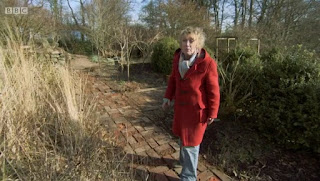
Later in the year they will be full of exotic plants like Banana, Dahlias and Cannas with outrageous zingy colours.
There is a big track that dissects the garden and her favourite part the Woodland and she has planted all the trees to create the shady area.

Her 2 daughters Annie and Alice each have their own garden.
Alice's garden is full of her favourite colours, crimson, pink and white, she is 28 years old and lives in Brighton and loves to see her garden when she visits.
Annie is her eldest daughter she is 29 years old and in South America and she wants her to come visit to see what she plans for the garden and to help out.
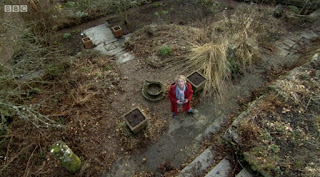
Like the rest of the garden this looks dormant but there is still life there underneath the soil and all sorts of things are going on ready for when the shoots all start sprouting and the garden is green again.
January

January and February are the bleakest and coldest of the Winter but have the first of the years colour and Carol is already thinking about the first seeds to sow.
The short days are spent clearing the debris of the previous year and getting it ready for the growing year.
Carol is up a big ladder sorting out her Clematis Huldine which is a member of the Viticella group and is smothering and distorting the branches of her Crab Apple Tree.
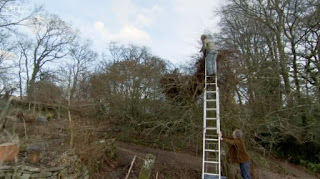
Her husband Neil is holding the ladder as she pulls away the Clematis that ideally should be pruned when dormant but is already budding.
This can be pruned right back to 2 buds from the base of the plant but as it is already budding she does not want to lose all the top flowers.
Carol is trying to remove the bulk of the plant then re-introduce a few select shoots.
She said this winter (2010-2011) has probably been the cruellest Winter since they have lived there and have had deep snow and they were snowed in for a fortnight!
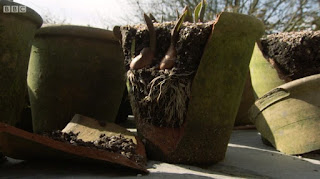
But worse than that has been the severe frosts as this does the worse damage and her tulip pots have been shattered and to the brick paths which have crumbled in places.
Lots of plants have been killed or damaged.
Carol is down from the ladder and sends Husband and ladder holder Neil to put the kettle on for a cuppa.

The tree is now clear of its Clematis canopy and she can now see what needs pruning for the Crab Apple tree.
At ground level there are loads of Clematis stems layered into the ground and she wants to take some out and retain the rest so the starry flowers will reach the top branches.
She prunes like you would normally a group 3 Clematis, so she traces the stem to the ground and leaving 2 or 3 buds she cuts it straight across to the buds.
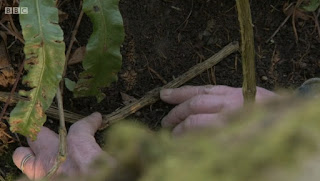
Carol then makes a small trench and plants the stem and weights it down with a stone, each bud will make a new shoot.
She will keep checking it for new shoots and then she will replace the stone with a staple.
The strand she cut off is still in the tree and she does her best bell ringer impression to pull it out of the branches.
Mid January
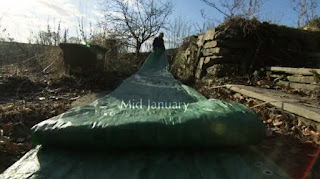
Carol is dragging a long tarpaulin over the path and starts clearing the bed of all the dull brown foliage and puts it into a wheelbarrow.
She says the garden looks like a 'sepia photograph'.
She is working in Annie's garden and this year it is having a major revamp but the first job is to clear all of last year left over debris.

Once its all been cleared Carol can identify each clump of plants and she is going to lift them and put on the tarpaulin.
She will then do a stock take and then design the garden layout.
At the end of the border is a very old apple tree that is full of canker and disease so she needs to decide what to do with that!
They have tried various things to cure it but now the time to decide if it is to stay or go.
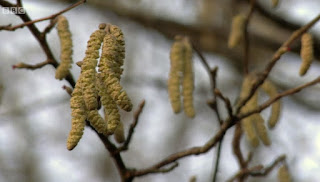
Carol says Winter seems a long season as its the time when everything is dormant, dead or dying and brown but things are starting to happen in the garden.
Shoots are starting to break through the ground, Catkins and Lamb's Tails are in the hedges.
Snowdrops
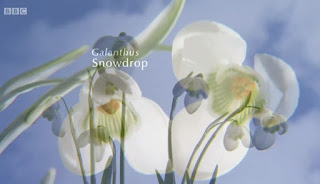
The stars at this time of year are the Snowdrops, you can almost hear them coming up as they shoot through the dank earth.
The flowers are a perfect design that have a long pedicel, the stalk that holds the bell shaped flower looks to delicate to hold the weight but it enables the bells to move backwards and forwards in the Winter winds.
The Snowdrops clump together and you can dig them up just as they go to ground and divide the clumps.
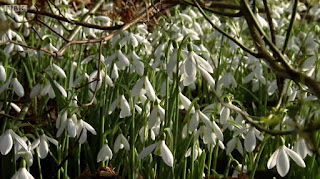
Once divided the bulbs need replanting straight away.
There is another way to divide them in June or July when the bulbs are dormant you slice them vertically with a very clean knife so that everything is sterile.
Each segment you cut off needs to have 2 scales and a bit of the Basal plate of the bulb.

The pieces are then placed in a bag of Vermiculite in a warm dark place until they start rooting which takes a few weeks.
They are then planted out in good compost in seed trays, it then takes a couple of years to form decent sized bulbs that can be planted on, into the garden.
Late January
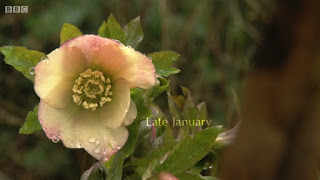
Carol has been making lots of progress in Annie's garden but then a typical wet January has set in and stopped work outside.
Luckily there is the potting shed to retreat to and Carol loves it as its dark outside and she can carry on working in the shed.
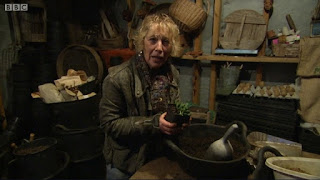
She says there is always so much to do and everything is close at hand.
She has some primroses she had potted and looking at them she thinks about how they are going to grow outside as the year progresses.
February

Carol has finally cleared Annie's garden of all the debris and after a very wet night she was unable to make her planned early start, lifting the plants.
While she is waiting for the soil to dry out she is going to take out a Phlomis Lanata which comes from a hot sunny climate and it has grey furry leaves.

She took the cuttings in June / July and took off some side shoots including the heel, then she nipped the top off and put them in a pot of gritty compost.



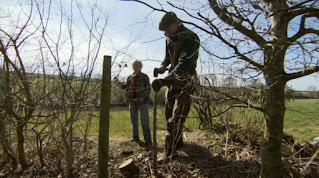
He starts by cutting off some branches then makes partial cuts in the base of the hedge so it can be pulled over and bent to the side to weave it into the stake he has put into the ground.
They root really quickly and Carol will be planting them out in the garden when the weather gets warmer.
Carol can now get on in Annie's garden and starts by digging up a Phlox which was tiny when first planted now it has a huge root ball.

She is placing them as she digs them up on her tarpaulin and she will then divide them once the plants are all dug up and some will go in the nursery bed.
Once they are all up then Carol can get to work on the soil preparation ready for her new design for the garden.
Carol says each day is different out in the garden at this time of year, some days are foggy other days bright sunshine.
Garlic
On the shortest day, the Winter Solstice is when you should put your Garlic in the ground.

The ground is very wet and soggy in her garden so she starts hers off in module seed trays to give them the best start.
This then goes on the greenhouse shelf.
Mid February

The weather in Carol's garden is usually from the Atlantic to the West of the garden but this changes in February when the bitterly cold East wind comes.
Carol is taking down her rickety Wattle fence panels as the wind has finished them off and she wants to get to the hedge behind them.
The hedge is native and Marcus Tribe Woodsman is coming to help Carol lay the hedge that runs the length of the garden.

Carol and Marcus squeeze through the hedge, something he is very used to, so they can see the hedge from the other side.
Marcus says it has grown enough to 'lay' to match the rest of the hedge and get his tools and stakes ready.
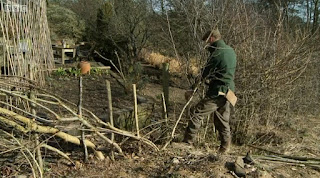
He cuts no more than 3 quarters of the way through and you want some of the Cambium layer and bark remaining to keep it alive and using his Billhook to split it and gently pull it over to the side.
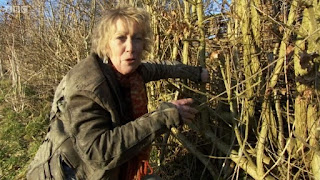
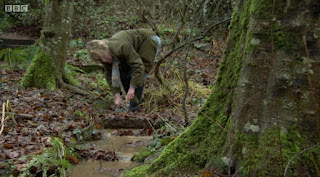



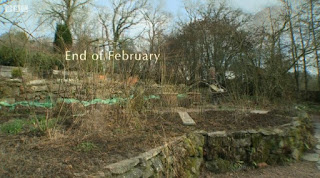

The supports or stakes are made out of Hazel and the branch is weaved around it.
The tree sap will rise up the tree encouraging new shoots to come off the 'laid' branches.
In future years more branches will be laid as they grow.

Carol shows us a part of the hedge Marcus laid 4 years ago to show us how by laying the laterals loads of new shoots have grown making a dense hedge.
These shoots can now be laid to make it even denser, and it will keep being done.
This also gives Carol the opportunity to have about 10 - 12 different native species to form a rich tapestry of leaves, flowers and fruit which the wildlife loves.

Carol other favourite part is the Woodland area and in one corner is a lovely little stream.
After all the rain and snow it is quite fast flowing but is clogged up with Autumn debris so Carol is clearing its path.
Hellebore

In the Woodland the Hellebore have spread and Carol likes how different they all are, you can get pure white ones and come in a huge range of colours and even in black.
They are mostly maintenance free except Carol likes to cut all the old leaves off to stop any diseases and also to let light into the centre of the plant so the new growth can shoot through.
If you have a few Hellebores you can try pollinating them which Carol finds exciting.

You do this by choosing 2 plants and with a little paintbrush or pen lid you collect the pollen from one and then you find a flower thats just opening on the other plant and pull the petals and then introduce the pollen to its Stigma in the flowers centre.
You then close up the petals and repeat the process in 3 days and she ties some thread or string around the flower to identify it.

You then wait to June / July and when the seed capsules start to burst you collect the seeds in a paper bag and sow directly on the surface of good compost.
Cover it in grit and leave outside, watering it regularly and in September your new strain of Hellebores will start to pop through.
You keep potting them on and in a few years your flowers will be revealed.
End of February

The long Winter is coming to an end and Carol is back in Annie's Garden which has been dug over now all the plants have been removed and she is adding compost to it.
The compost is rich and black and she feeds the soil and not the plants by adding this and she finds the compost magical.

All the plants from the garden that have died back to make the compost and the detritus has just turned its self with the help of worms and micro-organisms into this amazing compost that will feed the garden.
The Winter months have gone slowly but they lay the foundations for the rest of the growing year and Carol can already smell Spring in the air.

No comments:
Post a Comment